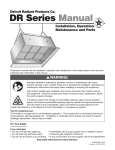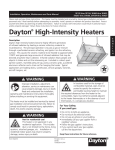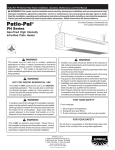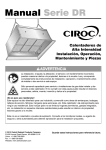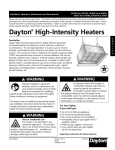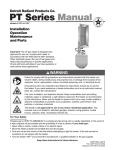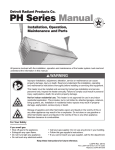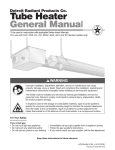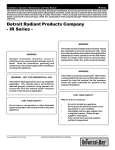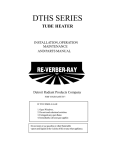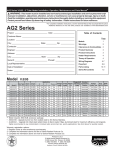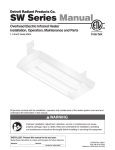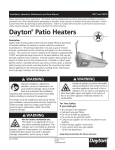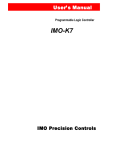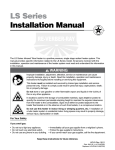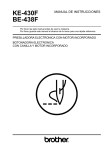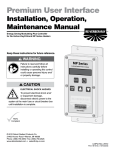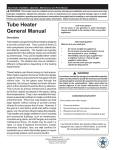Download Detroit Radiant Products DR 55 Troubleshooting guide
Transcript
Detroit Radiant Products Co. DR Series Manual Installation, Operation Maintenance and Parts ! All persons involved with the installation, operation and maintenance of the heater system must read and understand the information in this manual. ! WARNING Improper installation, adjustment, alteration, service or maintenance can cause property damage, injury or death. Read and understand the installation, operating and maintenance instructions thoroughly before installing or servicing this equipment. Only trained, qualified gas installation and service personnel may install or service this equipment. Failure to comply could result in personal injury, asphyxiation, death, fire and/or property damage. In locations used for the storage of combustible materials, signs must be posted to specify the maximum permissible stacking height to maintain the required clearances from the heater to the combustibles. Signs must either be posted adjacent to the heater thermostats or in the absence of such thermostats, in a conspicuous location. Not for residential use! This heater is not approved in any residential application. This includes (but is not limited to) the home, living quarters, attached garages, etc. Installation in residential indoor spaces may result in property damage, asphyxiation, serious injury or death. For Your Safety If you smell gas: • Do not try to light any appliance. • Immediately call your gas supplier from a neighbor’s phone. • Do not touch any electrical switch. • Follow the gas supplier’s instructions. • Do not use any phone in your building. • If you cannot reach your gas supplier, call the fire department. Keep these instructions for future reference. LIODR-Rev. 25911 Print: 5M-10/12_r2-10/13(CDS) Replaces: LIODR-5M-9/11(CDS) DR Series Manual Contents 1.0 Safety . . . . . . . . . . . . . . . . . . . . . . . . . . . . . . . . . . . . . . . . . . . . . . . . . . . . . . . . . . . . . . . . . . . . Safety Symbols . . . . . . . . . . . . . . . . . . . . . . . . . . . . . . . . . . . . . . . . . . . . . . . . . . . . . . . Applications . . . . . . . . . . . . . . . . . . . . . . . . . . . . . . . . . . . . . . . . . . . . . . . . . . . . . . . . . . Clearance to Combustibles . . . . . . . . . . . . . . . . . . . . . . . . . . . . . . . . . . . . . . . . . . . . . . Gas Connection . . . . . . . . . . . . . . . . . . . . . . . . . . . . . . . . . . . . . . . . . . . . . . . . . . . . . . . Standards, Certifications and Government Regulations . . . . . . . . . . . . . . . . . . . . . . . . Safety Signs and Labels . . . . . . . . . . . . . . . . . . . . . . . . . . . . . . . . . . . . . . . . . . . . . . . . . 3 3 3 4 6 6 8 2.0 Installation . . . . . . . . . . . . . . . . . . . . . . . . . . . . . . . . . . . . . . . . . . . . . . . . . . . . . . . . . . . . . . . 9 Design . . . . . . . . . . . . . . . . . . . . . . . . . . . . . . . . . . . . . . . . . . . . . . . . . . . . . . . . . . . . . 9 Heater Placement . . . . . . . . . . . . . . . . . . . . . . . . . . . . . . . . . . . . . . . . . . . . . . . . . . . . . 10 Total Area Heating . . . . . . . . . . . . . . . . . . . . . . . . . . . . . . . . . . . . . . . . . . . . . . . . . . 10 Spot Heating . . . . . . . . . . . . . . . . . . . . . . . . . . . . . . . . . . . . . . . . . . . . . . . . . . . . . . 11 Heater Mounting . . . . . . . . . . . . . . . . . . . . . . . . . . . . . . . . . . . . . . . . . . . . . . . . . . . . . . 12 Ventilation . . . . . . . . . . . . . . . . . . . . . . . . . . . . . . . . . . . . . . . . . . . . . . . . . . . . . . . . . . . 14 Gas Supply . . . . . . . . . . . . . . . . . . . . . . . . . . . . . . . . . . . . . . . . . . . . . . . . . . . . . . . . . . 15 Electrical . . . . . . . . . . . . . . . . . . . . . . . . . . . . . . . . . . . . . . . . . . . . . . . . . . . . . . . . . . . . . 17 3.0 Operation . . . . . . . . . . . . . . . . . . . . . . . . . . . . . . . . . . . . . . . . . . . . . . . . . . . . . . . . . . . . . . . . . 19 4.0 Maintenance . . . . . . . . . . . . . . . . . . . . . . . . . . . . . . . . . . . . . . . . . . . . . . . . . . . . . . . . . . . . . . 20 Troubleshooting Guide . . . . . . . . . . . . . . . . . . . . . . . . . . . . . . . . . . . . . . . . . . . . . . . . . 21 Heater Assembly Components . . . . . . . . . . . . . . . . . . . . . . . . . . . . . . . . . . . . . . . . . . . 22 Parts Listing . . . . . . . . . . . . . . . . . . . . . . . . . . . . . . . . . . . . . . . . . . . . . . . . . . . . . . . . . . 23 5.0 Limited Warranty . . . . . . . . . . . . . . . . . . . . . . . . . . . . . . . . . . . . . . . . . . . . . . . . . . . . . . . . . . 24 2 DR Series Manual 1.0 Safety • Safety Symbols • Applications 1.0 Safety ! ! WARNING Improper installation, adjustment, alteration, service or maintenance can cause property damage, serious injury or death. Read and understand the installation, operating and maintenance instructions thoroughly before installing or servicing this equipment. Only trained, qualified gas installation and service personnel may install or service this equipment. Safety Symbols Safety is the most important consideration during installation, operation and maintenance of the infrared heater. You will see the following symbols and signal words when there is a hazard related to safety or property damage. ! ! WARNING Warning indicates a potentially hazardous situation which, if not avoided, could result in death or injury. CAUTION Caution indicates a potentially hazardous situation which, if not avoided, could result in minor or moderate injury. NOTICE Notice indicates a potentially hazardous situation which, if not avoided, could result in property damage. Applications This is not an explosion proof heater. Consult your local fire marshall, insurance carrier and other authorities for approval of the proposed installation. Commercial / Industrial Infrared heaters are designed and certified !for use in industrial and commercial buildings such as warehouses, manufacturing plants, aircraft hangars and vehicle maintenance shops. For maximum safety, the building must be evaluated for potential hazards before installing the heater system. A critical safety factor to consider before installation is the clearance to combustibles. Residential This heater is NOT approved for use in any residential application. This includes, but not limited to, attached garages, living quarters, solariums, etc. Consult the local fire marshal and/or insurance provider if unsure of your application. ! WARNING Not For Residential Use. Installation of an infrared heater system in residential indoor spaces, RV’s, mobile homes, etc. may result in property damage, asphyxiation, fire, serious injury or death. 3 DR Series Manual 1.0 Safety • Clearance to Combustibles Clearance to Combustibles ! WARNING Improperly connected gas lines may result in serious injury or death, explosion, poisonous fumes, toxic gases, asphyxiation. Connect gas lines in accordance to national, state, provincial and local codes. Placement of explosive objects, flammable objects, liquids and vapors close to the heater may result in explosion, fire, property damage, serious injury or death. Do not store, or use, explosive objects, liquids and vapor in the vicinity of the heater. Failure to comply with the published clearances to combustibles could result in personal injury, death and/or property damage. ! CAUTION Signs shall be posted specifying the maximum permissible stacking height in order to maintain clearances to combustibles. Hazards Include: For maximum safety the building must be evaluated for hazards before installing the heater system. Examples include, but are not limited to: • • • • • • • Gas and electrical lines Combustible and explosive materials Chemical storage areas Areas of high chemical fume concentrations Provisions for accessibility to the heater Adequate clearances around air openings Combustion and ventilating air supply • • • • • • • Vehicle parking areas Vehicles with lifts or cranes Storage areas with stacked materials Lights Sprinkler heads Overhead doors and tracks Dirty, contaminated environment A critical safety factor to consider before installation is the clearances to combustibles. Clearance to combustibles is defined as the minimum distance you must have between the infrared surface, or reflector, and the combustible item. Considerations must also be made for moving objects around the infrared heater. The following is a partial list of items to maintain clearances from: Combustible Items Include: Moving Objects Include: • • • • • • • • • • Wood Paper Fabric Chemicals Wall or roof insulation Overhead doors Vehicles on lifts Cranes Hoists Car wash equipment When installing the infrared heater system, the minimum clearances to combustibles must be maintained. These distances are shown in Chart 1.1 and on the heater. If you are unsure of the potential hazards, consult your local fire marshall, fire insurance carrier or other qualified authorities on the installation of gas fired infrared heaters for approval of the proposed installation. 4 DR Series Manual 1.0 Safety • Clearance to Combustibles Chart 1.1 • Clearance to Combustibles in Inches (see Figure 1.1) Model No. Sides Back Top Below/Front DR 30 (S) 30 18 28 72 DR 45 30 18 28 72 DR 50 30 18 34 72 DR 55 32 18 40 72* DR 60 32 18 40 72* DR 75 48 30 42 98 DR 80 48 30 42 98 DR 85 48 30 42 98 DR 90 48 30 42 98 DR 95 48 30 52 120 DR 100 48 30 52 120 DR 130 48 30 52 120 DR 160 50 32 60 132 * This clearance is 80 in. when the heater is fitted with a parabolic reflector. NOTE: If the heater is mounted beneath a non-combustible surface, a 24 in. minimum top clearance must be maintained from the top of the heater to prevent overheating the controls. Figure 1.1 • Clearance to Combustibles Top Back Manifold or Control End Side Side Front 20° - 35° Mount Heater Level - Side to Side Below FRONT VIEW SIDE VIEW 5 1.0 Safety • Gas Connection • Standards, Certifications and Government Regulations DR Series Manual Gas Connection ! WARNING An approved connector, suitable for the environment of equipment usage, is required. Visible or excessive swaying, flexing and vibration of the gas connections must be avoided to prevent failure. Neither the gas pipe nor the connector shall be placed in the ‘flue discharge area’. In no case shall the gas supply support the weight of the heater. To ensure your safety, and comply with the terms of the warranty, all units must be installed in accordance with these instructions. Standards, Certifications and Government Regulations Installation of this infrared heater must comply with all applicable local, state and national specifications, regulations and building codes. Contact the local building inspector and/or fire marshall for guidance. In the absence of local codes, the installation must conform to the latest edition of: United States: National Fuel Gas Code, ANSI Z223.1 (NFPA 54). Canada: CAN/CGA B149.1 and .2, Canadian Electrical Code C22.1 Chart 1.2 • Standards and Code Installation Guidelines • Building Aspect Building Aspect Electrical Codes and Guidelines The heater must be electrically grounded in accordance with the following codes: United States: Refer to National Electrical Code®, ANSI/NFPA 70 (latest edition). Wiring must conform to the latest edition of National Electrical Code®, local ordinances, and any special diagrams furnished. Canada: Refer to Canadian Electrical Code CSA C22.1 Part 1 (latest edition). Venting The space being heated by unvented heaters must meet ventilation requirements. 6 DR Series Manual 1.0 Safety • Standards, Certifications and Government Regulations Chart 1.3 • Standards and Code Installation Guidelines • Building Type Building Type Codes and Guidelines Public Garages Installation of this infrared heater in public garages must conform to the following codes: United States: Standard for Parking Structures NFPA 88A (latest edition) or the Code for Motor Fuel Dispensing Facilities and Repair Garages NFPA 30A (latest edition). Canada: R efer to CAN/CGA B149.1 and B149.2: Installation Codes for Gas Burning Appliances. Guidelines: • Heaters must not be installed less than 8 ft. (2.4 m) above the floor. Minimum clearances to combustibles must be maintained from vehicles parked below the heater. Aircraft Hangars • When installed over hoists, minimum clearances to combustibles must be maintained from the upper most point of objects on the hoist. Installation of this infrared heater in aircraft hangars must be in accordance with the following codes: United States: Refer to Standard for Aircraft Hangars, ANSI/NFPA 409 (latest edition). In Canada:Refer to Standard CAN/CGA B149.1 and B149.2. Guidelines: • In aircraft storage and servicing areas, heaters shall be installed at least 10 ft. (3 m) from above the upper surface of wings or of the engine enclosures of the highest aircraft that may be housed in the hangar. The measurement shall be made from the wing or engine enclosure, whichever is higher from the floor, to the bottom of the heater. • In areas adjoining the aircraft storage area (e.g., shops, offices) the bottom of heaters shall be installed no less than 8 ft. (2.4 m) above the floor. • Suspended or elevated heaters shall be located in spaces where they shall not be subject to damage by aircraft, cranes, movable scaffolding or other objects. Provisions shall be made to assure accessibility to suspended infrared heaters for recurrent maintenance purposes. Detroit Radiant Products units comply or are certified by one or more of the following organizations or standards: • CSA Design Certified (CSA 2.35). • American National Standards (ANSI Z83.19). • Underwriters Laboratory (UL). • Certification of Europe (CE). • Infrared Heater Safety Council. (IRSC). 7 DR Series Manual 1.0 Safety • Safety Signs and Labels Safety Signs and Labels It is important to provide warnings to alert individuals to potential hazards and safety actions. ANSI Z83.19 and the National Fuel Gas Code require you to post a sign “specifying the maximum permissible stacking height to maintain the required clearances from the heater to the combustibles” near the heater’s thermostat or in absence of such thermostats in a conspicuous location. Signs should state the hazards for the particular application and be legible to the building occupants. Consult the factory or a factory representative for additional information on signage compliance. Safety warning labels must be maintained on the infrared heater. Illustrations of the safety labels, and their locations, are pictured below. ® RE-VERBER-RAY INFRA-RED RADIANT HEATER FOR OUTDOOR USE AND INDOOR (Non-Residential) INSTALLATION ONLY. High - Intensity Infrared Heater Class IIIA Permanent Label MODEL NO. DR60-NFS-2 120 Volts AC: Back View 120V - 60Hz AMPS - Starting: 0.1 AMPS - Running: 0.1 Heater Type: INPUT BTU/H VERSION 05/97 60,000 LE Manifold Pressure: 6.0 in. MP W.C.P. Maximum Inlet Pressure: SA 14 in. W.C.P. Natural Gas Heater Type C1 Minimum Mounting Angle: 20 DEGREES Minimum Inlet Pressure: 7.0 in. FOR USE WITH Maximum Mounting Angle: W.C.P. 35 DEGREES C1 DESIGN COMPLIES WITH: Serial No. 08 07 DRPC 123456 0001 ANSI Z83.20-2001-GAS FIRED LOW INTENSITY INFRA-RED HTR. DETROIT RADIANT PRODUCTS COMPANY 21400 HOOVER ROAD - WARREN, MI (586) 756-0950 www.drp-co.com Rating Plate Bottom View ® RE-VERBER-RAY INFRA-RED RADIANT HEATER FOR OUTDOOR USE AND INDOOR (Non-Residential) INSTALLATION ONLY. High - Intensity Infrared Heater Class IIIA Permanent Label MODEL NO. INPUT BTU/H DR60-NFS-2 120 60,000 Volts AC: VERSION 05/97 Manifold Pressure: 120V - 60Hz 6.0 in. AMPS - Starting: W.C.P. Maximum Inlet Pressure: 0.1 14 in. AMPS - Running: W.C.P. Minimum Inlet Pressure: 0.1 7.0 in. W.C.P. FOR USE WITH Natural Gas Heater Type C1 Minimum Mounting Angle: 20 DEGREES Maximum Mounting Angle: 35 DEGREES Heater Type: C1 DESIGN COMPLIES WITH: ANSI Z83.20-2001-GAS FIRED LOW INTENSITY INFRA-RED HTR. Serial No. 08 07 DRPC 123456 0001 DETROIT RADIANT PRODUCTS COMPANY 21400 HOOVER ROAD - WARREN, MI (586) 756-0950 www.drp-co.com F/N: LL01 - Clearance Safety Tag (Affix adjacent to heater’s thermostat) F/N: LLDR002 8 F/N: LLDCL002 Clearance to Combustibles Label DR Series Manual 2.0 Installation • Design 2.0 Installation WARNING ! Read and understand, the installation, operating and maintenance instructions thoroughly before installing or servicing this equipment. Only trained, qualified gas installation and service personnel may install or service this equipment. ! CAUTION This heater cannot be used in a building with an uninsulated roof or condensation problems can occur. Design To ensure a safe, properly designed heating system, a layout should be developed for the correct placement of the infrared heater(s). Aside from safety factors such as clearance to combustibles (see Chart 1.1 on page 5), you should take also into consideration the environment (e.g., cold/drafty, average, protected), heat coverage (sq. ft.) needed, heater centers, the distance behind a person or work station(s) and exhaust path. Also, the effective infrared surface temperature of a person or object may be diminished with wind above 5 mph. Wind barrier(s) may be required. Most importantly, clearance to combustibles must always be maintained! Refer to hazards on page 4. This installation manual, along with national, state, provincial and local codes, address these issues. It is critical that you read, understand and follow all guidelines and instructions. Always inspect and evaluate the mounting conditions, space for exhaust, gas supply and wiring. Perimeter mounting of infrared heaters provides the most effective distribution of heat. The recommended spacing between the heaters is shown in Chart 2.1. Add additional heaters in the center of the space when heaters are spaced farther than the recommended distance (see Figure 2.1 ). When heated, materials high in hydrocarbons (solvents, paint thinner, mineral spirits, formaldehydes, etc.) can evaporate. This may result in odors or fumes being emitted into the environment. To correct this problem, clean the area and/or introduce additional ventilation. Heaters installed and serviced in accordance with the installation manual do not emit foul odors into the environment. IMPORTANT: Fire sprinkler heads must be located at an appropriate distance from the heater. This distance may exceed the published clearance to combustibles. Certain applications will require the use of high temperature sprinkler heads or relocation of the heaters. Sprinkler systems containing propylene glycol or other flammable substances are not to be used in conjunction with this heater without careful consideration for and avoidance of potential fire or explosion hazards. For further information consult NFPA 13. Always observe applicable state and local codes. 9 DR Series Manual 2.0 Installation • Heater Placement Chart 2.1 • Recommended Mounting Heights and Distances for “Total Area” Heating Mounting Heights Dim. A Model No. 30º Angle Standard Reflector (ft.) 30º Angle Parabolic Reflector (ft.) Distance Between Heaters Dim. B (ft.) Distance Between Heater Rows Dim. C (ft.) Distance Between Heater and Wall (ft.) DR 30(S) 12-14 12-15 8-24 15-40 4-8 DR 45 12-14 16-19 12-36 15-55 6-12 DR 50 12-14 17-20 12-36 15-55 6-12 DR 55 13-15 18-21 12-36 15-55 6-12 DR 60 14-16 18-21 12-36 15-55 6-12 DR 75 15-17 19-22 16-48 20-70 6-12 DR 80 15-17 19-22 16-48 20-70 6-12 DR 85 16-18 21-25 16-48 20-70 6-12 DR 90 16-18 21-25 16-48 20-70 6-12 DR 95 17-20 21-25 16-48 20-70 6-12 DR 100 17-20 23-27 16-48 20-70 6-12 DR 130 21-24 26-32 20-60 25-85 8-14 DR 160 24-28 29-35 24-65 30-100 8-14 Factory recommended mounting heights are listed as a guideline. If infrared heaters are mounted too low or too high, they may result in discomfort or lack of heat. Detroit Radiant Products Company generally recommends observing the recommended mounting heights to optimize comfort conditions. However, certain applications such as spot heating, freeze protection, outdoor patio heating or very high ceilings may result in the heaters being mounted outside of the recommended mounting heights. Figure 2.1 • Total Area Heating Sample Layout B Key Infrared heater B Thermostat C Air intake louver Exhauster A A Perimeter mounting Perimeter and center row mounting 10 DR Series Manual 2.0 Installation • Heater Placement Centers for Full Coverage (Spot & Area) Htg. Only 12’ DR-30 Cold/Drafty 10’ x 10’ 100 9’ 30,000 BTU/h Average 12’ x 12’ 144 10’ 12’ Protected/Insul. 14’ x 14’ 196 DR-45 Cold/Drafty 12’ x 12’ 144 10’ 12’ 45,000 BTU/h Average 14’ x 14’ 196 Protected/Insul. 16’ x 16’ 256 DR-60 Cold/Drafty 16’ x 16’ 256 60,000 BTU/h Average 18’ x 18’ 324 Protected/Insul. 20’ x 20’ 400 DR-75 Cold/Drafty 18’ x 18’ 324 75,000 BTU/h Average 22’ x 22’ 484 Protected/Insul. 26’ x 26’ 676 DR-90 Cold/Drafty 20’ x 20’ 400 90,000 BTU/h Average 24’ x 24’ 576 Protected/Insul. 28’ x 28’ 784 DR-95 Cold/Drafty 24’ x 24’ 576 18’ 95,000 BTU/h Average 28‘ x 28’ 784 18’ Protected/Insul. 32’ x 32’ 1024 DR-100 Cold/Drafty 24’ x 24’ 576 18’ 100,000 BTU/h Average 28‘ x 28’ 784 18’ Protected/Insul. 32’ x 32’ 1024 DR-130 Cold/Drafty 26’ x 26’ 676 18’ 130,000 BTU/h Average 30’ x 30’ 900 18’ 12’ 28’ Protected/Insul. 35’ x 35’ 1225 20’ 22’ 13’ 32’ DR-160 Cold/Drafty 28’ x 28’ 784 20’ 22’ 12’ 28’ 160,000 BTU/h Average 35’ x 35’ 1225 16’ 32’ Protected/Insul. 40’ x 40’ 1600 20’ 35’ Recommended Mounting Height (Dim. A) Approx. Coverage (sq. ft.) 5’ Approx. Area Covered 10’ Type of Area (Surroundings) 4’ Model & Input Distance Behind Person or Work Station (Dim. B) Chart 2.2 • Recommended Mounting Heights and Distances for “Spot” Heating 10’ 12’ 14’ 16’ 18’ 20’ 22’ 24’ 26’ 28’ 30’ 12’ 12’ 14’ 14’ 5’ 12’ 6’ 14’ 16’ 7’ 16’ 6’ 16’ 16’ 7’ 18’ 8’ 20’ 7’ 18’ 14’ 14’ 12’ 6’ 14’ 14’ 16’ 14’ 18’ 16’ 16’ 18’ 18’ 16’ 20’ 18’ 18’ 20’ 20’ A 11 24’ 9’ 20’ 10’ 24’ 11’ 26’ 24’ 20’ 11’ 26’ 20’ 12’ 26’ 10’ 24’ 20’ 11’ 26’ 20’ 12’ 30’ 11’ 26’ 20’ 26’ 28’ B 22’ 10’ 24’ Figure 2.2 • Spot Heater Heights 8’ 9’ 30’ DR Series Manual 2.0 Installation • Heater Mounting Heater Mounting ! WARNING Improper suspension of the infrared heater may result in collapse and being crushed. Always suspend from a permanent part of the building structure that can support the total force and weight of the heater. Failure to maintain minimum clearance to combustibles may result in fire and/or explosion, property damage, serious injury or death. Always maintain minimum clearances and post signs or provided tags (F/N: LL01) where needed. Signs should state the hazards for the particular application and be legible to the building occupants. Consult the factory or a factory representative for additional information on signage compliance. An approved connector, suitable for the environment of equipment usage, is required. Visible or excessive swaying, flexing and vibration of the gas connections must be avoided to prevent failure. Neither the gas pipe nor the connector shall be placed in the ‘flue discharge area’. In no case shall the gas supply support the weight of the heater. The heater can be suspended with chains or rigid threaded rod. Local codes, or conditions that would cause the unit to move (e.g., wind drafts, blowers, crane rails, etc.), may require rigid threaded rod. Consult all applicable codes before installation. The heater must be level from side to side and between 20° and 35° from horizontal. The pilot burner or ignitor, manifold and controls must be located on the lower end. Refer to figures 2.3 and 2.4. Figure 2.3 • Heater Mounting Steel “C” clamp Chain hanging set Rigid threaded rod Closed “S” hook (typical) Control End Down 20˚ - 35˚ Control End Down 20˚ - 35˚ SIDE VIEW SIDE VIEW 12 DR Series Manual 2.0 Installation • Heater Mounting Figure 2.4 • Heater Orientation Manifold control box must be located towards the lower end of the heater (towards the floor). Pilot/spark electrode must be in lower right corner. (excludes DR30S) Mount Heater Level - Side to Side Mount 20˚ - 35˚ from horizontal SIDE VIEW FRONT VIEW Figure 2.5 • Gas Connection NOTE: Use a regulator when gas supply pressure exceeds 14” W.C.P. Do not exceed 14” W.C.P to the appliance. TOP VIEW Steel C-clamp Chain hanging set Disconnect switch Drip Leg/Sediment Trap 20˚ - 35˚ Ball Valve / Inlet Tap SIDE VIEW Stainless Steel Gas Connector, formed into a smooth C-Shape (Field Supplied) Not for use with rigidly mounted heaters. 13 DR Series Manual 2.0 Installation • Ventilation Ventilation ! WARNING Insufficient ventilation may result in health problems, carbon monoxide poisoning or death. Vent enclosed spaces and buildings according to national, state, provincial and local codes. Improper venting may result in asphyxiation, fire, explosion, injury or death. It is required that the levels where heaters are mounted be properly ventilated to supply combustion air to the heaters and to sufficiently dilute the products of combustion. It is also required that the flue discharge area is kept clear of gas piping and electrical wiring (see Figure 2.6). This infrared heater must be vented in accordance with national, state, provincial and local codes and the guidelines in this manual. In the United Sates refer to the latest edition of ANSI Z223.1 (NFPA 54) and in Canada refer to the latest edition of the CAN/CGA B149.2 Standard. Figure 2.6 • Hot Flue Discharge Flue Discharge Area Important! Do not install gas piping or electrical wiring above the flue discharge area! Manifold/Control End Down 20˚ - 35˚ SIDE VIEW Provisions must also be made to provide sufficient fresh air intake area and exhaust air outlet area. For proper ventilation, a positive air displacement of 4 cfm/1,000 BTU/h of gas consumed must be provided. Where insufficient air movement exists, induced air displacement is required. A balanced system is essential to avoid negative building pressure which causes excessive infiltration, unfavorable drafts and affects combustion efficiency. Air displacement may be accomplished by either natural or mechanical means. Mechanical exhausters are preferred and typically mounted at high points on the roof where stagnant air accumulates inside the building. For a flat roof, considerations of prevailing winds, high and low pressure areas, and distribution of air movement must be taken into consideration when locating exhausters. Best air distribution is accomplished by using a number of small exhausters versus one large exhauster. Provide a minimum of one square inch of inlet area per 1,000 BTU/h for combustion air supply. Inlet opening in the building should be well distributed (see Figure 2.1) high in the sidewalls and should direct incoming air upward to dilute products of combustion while preventing drafts at lower levels. Inlets are typically 1 to 3 sq. ft. Local codes may require that mechanical exhaust systems be interlocked with heaters to enable both to function simultaneously (see page 17, Figure 2.7) or allow control of exhausters with a ceiling mounted humidistat. 14 DR Series Manual 2.0 Installation • Gas Supply Gas Supply WARNING ! Improperly connected gas lines may result in fire, explosion, poisonous fumes, toxic gases, asphyxiation or death. Connect gas lines in accordance to national, state, provincial and local codes. The gas supply to the infrared heater must be connected and tested in accordance with national, state, provincial and local codes along with the guidelines in the Detroit Radiant DR Series manual. In the United States refer to the latest edition of the ANSI Z223.1 (NFPA 54) Standard and in Canada refer to the latest edition of the CAN/CGA B149.2 Standard. Important! Before connecting the gas supply to the infrared heater(s): • Check that the gas piping and service has the capacity to handle the load of all heaters being installed, as well as any other gas appliances being connected to the supply line. • Check that the main gas supply line is of proper diameter to supply the required fuel pressures. • If utilizing used pipe, verify that its condition is clean and comparable to a new pipe. Test all gas supply lines in accordance with local codes. • Test and confirm that inlet pressures are correct. Refer to the rating plate for required minimum and maximum pressures (see Chart 2.3). The gas supply pipe must be of sufficient size to provide the required capacity and inlet pressure to the heater (if necessary, consult the local gas company). Chart 2.3 • Manifold Pressure Type of Gas Required Manifold Pressure Minimum Inlet Pressure Maximum Inlet Pressure Natural 6.0 Inches W.C. 7.0 Inches W.C. 14.0 Inches W.C. Liquefied Petroleum 10.0 Inches W.C. 11.0 Inches W.C. 14.0 Inches W.C. ! Note: Check manifold pressure at the tap located either at the outlet of the gas valve or on the gas manifold pipe. Readings will be above atmospheric pressure during operation. Pressure Equivalents: 1 inch W.C. equals .058 oz/sq. in. equals 2.49 Mbar. To connect the gas: ! WARNING Failure to install, operate or service this appliance in the approved manner may result in property damage, injury or death. This heater must be installed and serviced by trained gas installation and service personnel only. The installation of this heater must conform with local building codes or, in the absence of such codes, the National Fuel Code (NFPA 54). 15 DR Series Manual 2.0 Installation • Gas Supply ! WARNING An approved connector, suitable for the environment of equipment usage, is required. Visible or excessive swaying, flexing and vibration of the gas connections must be avoided to prevent failure. Neither the gas pipe nor the connector shall be placed in the ‘flue discharge area’. In no case shall the gas supply support the weight of the heater. The gas outlet must be in the same room as the appliance and accessible. It may not be concealed within or run through any wall, floor or partition. 1 Install a sediment trap / drip leg if condensation may occur at any point of the gas supply line. This will decrease the possibly of loose scale or dirt in the supply line entering the heater’s control system and causing a malfunction. Note: High pressure gas above 14 in. W.C.P. (water column pressure) requires a high pressure regulator and ball valve (field supplied). 2 Form the stainless steel flexible connector (field supplied) into a smooth C-shape allowing 12 in. between the flexible connector’s end nuts. Figure 2.5 on page 13. NOTE: Not for use on rigidly mounted heaters. 3 Attach the ball valve (field supplied) to the gas supply pipe. Apply pipe compound to NPT adapter threads to seal the joint. Use only a pipe compound resistant to liquid petroleum. NOTE: Provide a 1/8 in. NPT plugged tapping accessible for test gauge connection immediately upstream of gas connection to the heater (provided on ball valve, when supplied). !! CAUTION The fittings (nuts) on the flexible connector must be connected to an adapter. They may not be directly connected to the gas supply pipe. 4 Attach the flexible connector to the adapter and gas inlet. Seal the joints. Note: Excessive torque on the manifold may misalign the orifice. Always use two wrenches to tighten mating pipe connections. ! WARNING Testing for gas leaks with an open flame or other sources of ignition may lead to a fire or explosion and cause serious injury or death. Test in accordance with NFPA or local codes. 5 Final assembly must be tested for gas leaks according to NFPA or local codes. ! CAUTION In high moisture or corrosive environments, use gas supply lines and connectors suitable for the environment. Periodically inspect for signs of failure or leakage. 16 DR Series Manual 2.0 Installation • Electrical Electrical ! WARNING Electric Shock Field wiring to the heater must be connected and grounded in accordance with national, state, provincial, local codes and to the guidelines in the this manual. In the United States refer to the most current revisions to the ANSI/NFPA 70 Standard and in Canada refer to the most current revisions the CSA C22.1 Part I Standard. Control systems are initiated by either 120 VAC, 24 VAC or millivolt energy. The 120 VAC systems can be used directly from a 120 VAC line. On 24 VAC systems, transformers must be used to supply power of sufficient VA rating for single or multiple connected installations. Important! Proper grounding and polarity are essential for heaters with spark ignition controls. If the system is not properly grounded, it cannot determine the presence of a flame and will lockout and shut off. Millivolt systems require NO external power, as energy needed to operate the valve is developed by the power-pile generator. Do not use multiple connections, as one thermostat may only control one heater. For wiring of controls on the unit see the wiring diagram included on page 18. It is recommended that the thermostat be installed on the hot side of a fused supply line and have a sufficient ampere capacity rating for the heater(s) it will control. The ventilation system may be controlled separately from the heating system (consult local codes) by the use of a humidistat that closes when the humidity rises. The humidistat control should be installed at roof level. For summer ventilation, a simple on/off switch can be installed at the occupant level. Figure 2.7 • Typical Field Wiring DR Series Heater DR Series Heater DR Series Heater Thermostat Transformer Exhaust Fan (required on 24V heaters) Hot Neutral 17 DR Series Manual 2.0 Installation • Wiring Diagrams Wiring Diagrams Figure 2.8 • NMV-2/PMV-2 • 750 Schematic • Millivolt Control N/PFS-2 24VAC Figure 2.9 • NFS-2/PFS-2 (24V) • 24 V Schematic • Direct Spark Ignition • VA Draw: 12 BL O ELECTRODE ASSEMBLY W (24VAC) W • Amps: .48 SENSE • Potted Circuit Board GROUND NEUTRAL THERMOSTAT VALVE W GAS VALVE 24VAC DSI MODULE G BK HIGH VOLTAGE G G (COMMON) Figure 2.10 • NFS-2/PFS-2 (120V) • 120 V Schematic •Direct Spark Ignition •VA Draw: 12 BK O ELECTRODE ASSEMBLY BK W •Amps: .10 •Potted Circuit Board L1 SENSE NEUTRAL LLWDR002 REV. 1 W THERMOSTAT NEUTRAL VALVE GROUND W GAS VALVE BK HIGH VOLTAGE 120VAC DSI MODULE G BK G G W 18 L2 DR Series Manual 3.0 Operation • Lighting Instructions 3.0 Operation ! WARNING Do not attempt to ignite a direct spark ignition heater by hand. Failure to comply could result in personal injury, property damage, explosion, fire or death. Upon satisfactory completion of the electrical supply and purging of the gas supply line to the heater(s), follow the lighting instructions on the heater’s rating label to put the heater into operation. Direct Spark Ignition (NFS-2 / PFS-2) Lighting Instructions 1Rotate the heater’s valve knob to the “ON” position. 2Close electrical circuit (typically the thermostat). 3If the heater fails to light, turn off gas, open electrical circuit and wait 5 minutes before repeating the above steps. Shutdown Instructions 1Open electrical circuit. 2Rotate the heater’s valve knob to the “OFF” position. Sequence of Operation Starting Circuit: Upon a call for heat, voltage is applied to L1 and Neutral. After a pre-purge, the spark electrode is energized and the gas valve opens. The trial for ignition is 15 seconds. If flame is not sensed, the heater will attempt two more times to reignite. Running Circuit: After ignition, the sensing electrode monitors the burner flame. If sense of flame is lost, the control immediately acts to reignite the gas-air mixture. If flame sense is not established within 15 seconds, the heater will attempt two additional ignition sequences before proceeding to hard lockout. The control can be reset by briefly interrupting the power source. Millivolt (NMV-2 / PMV-2) Lighting Instructions 1Purge main gas supply line. 2Slightly depress and rotate the heater’s manual gas valve knob COUNTERCLOCKWISE from the “OFF” position to the “PILOT” position. 3Fully depress the manual gas valve knob and light the pilot burner. Continue to depress for 30 seconds and then release. 4Rotate the heater’s valve knob to the “ON” position. 5Close the control circuit. If the heater fails to light, turn off the gas, open control circuit and wait 5 minutes before repeating the above steps. Shutdown Instructions 1Open the control circuit. 2Rotate the heater’s valve knob to the “PILOT” position, depress slightly and rotate to the “OFF” position. Sequence of Operation Starting Circuit: After manually lighting the pilot (see lighting instructions), upon a call for heat, the main burner solenoid is energized. The gas valve opens and the pilot lights the main burner. Running Circuit: After ignition, the powerpile monitors the pilot flame. If the pilot flame is lost, the powerpile cools and closes the valve within 180 seconds. See lighting instructions to relight the heater. 19 DR Series Manual 4.0 Maintenance • Maintenance Checks 4.0 Maintenance It is recommended that the following become a standard yearly procedure to obtain maximum operating efficiency and trouble free operation. During long periods of non-usage, remove or cover heater with a polyethylene bag and shut off gas supply. If further service to the heater is desired, contact your representative or the factory. Main Burner 1Gently use an air hose to blow any ! accumulated dust and/or dirt off the heater. Air hose pressure must not exceed 30 psig. Use protective glasses when cleaning the heater. 2Gently pass the air hose over the entire WARNING exposed area of the ceramic. A distance of 2’ to 4’ from the unit is recommended. NOTE: Blowing out the gasket material will permanently damage the rayhead. Disconnect power to heater before servicing. 3Gently place the air hose outlet into each Do not operate unit if repairs are necessary. Do not operate unit showing any signs of burner malfunction. Call a professional for assistance. venturi tube and allow the air to flow for approximately one minute. 4See troubleshooting chart (page 21) if there are any signs of burner malfunction. Replace if necessary. ! Pilot Burner CAUTION Avoid Equipment Failure. 1Remove pilot access door. Do not blow out heating elements with high pressure air. 2Use an air hose and gently blow the pilot burner free of dust or debris. Gas Supply 1 Periodically inspect the gas supply for signs of corrosion or failure. Replace if necessary. 20 DR Series Manual 4.0 Maintenance • Troubleshooting Chart 4.1 Troubleshooting Guide Symptom Code Possible Cause Corrective Action Burning of gas-air mixture inside plenum (flashback). A, B A, B A, B A, B A, B • Heater mounted at incorrect angle. • Excessive drafts. • Gas leaking or blocked orifice/venturi. • Separation of ceramic grids. • Ceramic grids cracked. • Mounting angle 20°-35° from horizontal. • Relocate or shield from draft. • Do not operate. Check with leak detector solution. • Do not operate. Replace rayhead. • Do not operate. Replace rayhead. Delayed ignition. A A, B A, B A, B A, B • Electrode out of specification. • Low gas pressure. • Partially blocked orifice. • Improper orifice size. • Incorrect gas. • See Figure 4.3. • See Gas Supply section. • Clean or replace. • Consult dealer. • Do not operate. See nameplate. Correct immediately. Low ceramic surface temperature, excessive rollout or soot on rods. A, B A, B A, B A, B • Dirty or plugged rayhead ceramics. • Partially blocked orifice. • Low inlet gas pressure. • Low manifold gas pressure. A, B • High manifold pressure. A, B A, B A, B • Foreign matter in venturi tube. • Gas supply piping too small. • Incorrect gas. • See maintenance instructions. • Remove and clean. • See Gas Supply section. • Adjust main valve regulator for 6” W.C.P. natural gas, 10” W.C. P. propane. • Adjust main valve regulator for 6” W.C.P. natural gas, 10” W.C. P. propane. • See Maintenance Section. • Increase inlet pressure or replace. • Do not operate. See nameplate. Correct immediately. Control system overheating. A, B A, B • Heater not mounted correctly. • Heater mounted too close to ceiling. • Mounting angle 20°-35° from horizontal. • Observe clearance to combustibles safety chart located on heater reflector. Do not operate. Gas odor. A, B • Loose pipe connection. • Pilot not lit. • Check all connections with leak-detector solution, tighten as necessary. • Cycle thermostat or manually light. • Heater located in drafty area. • Low gas pressure. • Thermostat located in drafty area. • Weak pilot flame. • Defective flame detector. • Relocate or shield from draft. • See Gas Supply section for propane. • Replace thermostat. • Clean or adjust pilot. • Replace. B Heater cycles repeatedly. A, B A A, B A, B B • Clean or adjust pilot. • Check thermostat, manual switch or circuit breaker. • Pilot sensor element not located in pilot flame. • Locate upper 3/4 of element in pilot flame. • Isolate. Ohm for resistance, replace if “0”. • Defective main valve solenoid. • Replace. • Defective pilot generator or thermocouple. • Excessive thermostat wire length with millivolt • Wire not to exceed length provided by factory. system. • Turn to “ON” position. • Manual valve off. Pilot on, no gas to main burner. B • Weak pilot flame. • No electrical power to unit. No spark; no ignition. A A A A A • Lack of 120V or 24V incoming voltage. • Open high voltage wire. • Improper electrode gap. • Loose or open wire connection. • Poor or no equipment ground. A A • Unit in “safety lockout” mode. • Defective “gas lighter” control. Heater lights, and “locks out” after approximately 10 seconds. A • Poor or no equipment ground. A A A A • Polarity is reversed. • Low gas pressure. • Electrode not sensing. • Heater mounted at incorrect angle. • Check all connections, provide positive earth ground. • 120V to black, neutral to white. • See Gas Supply section. • Relocate or replace if defective. • Mounting angle 20°-35° from horizontal. Spark is present. No main gas operation. Unit “locks out”. A A A • Gas valve in “Off” position. • Defective main valve solenoid. • Defective “Gas lighter” control. • Turn to “On” position. • Isolate and check for resistance. Replace if “0”. • Verify proper voltage. Replace. A, B A, B A, B • Defective thermostat or wiring. • Gas valve stuck open. • High gas pressure. • Replace or repair. • Replace. • See Gas Supply section. Heater will not shut off. Code: A - Direct Spark Ignition (NFS-2/PFS-2) • Proper voltage needed or repair wire. • Isolate and ohm for resistance, replace if “0”. • See Figure 4.3. • Check all wires, tighten or replace. • Trace ground wire for complete circuit back to equipment ground from control. • Interrupt power source, repeat trial for ignition. • Verify proper voltage. Replace. B - Standing Pilot (NMV-2/PMV-2) 21 DR Series Manual 4.0 Maintenance • Heater Assembly Components Heater Assembly Components For complete information on DR Series replacement parts, visit the online replacement parts library at http://www.reverberray.com/partscenter. For discontinued models, consult the factory. NOTE: Replacement burners are called “rayheads” with rod inserts (part no. DR-RH and DR-ROD). Ceramic grids are not sold separately, order DR-RH. Figure 4.1 • Heater Assembly Components (side view) Figure 4.2 • Heater Assembly Components (rear view of NFS-2/PFS-2) Heat Shield Cross-over Bracket Path of exhaust Rayhead Assembly with Ceramics Side Frame Brass Union Manifold Pressure Tap Manifold End Frame Assembly Rods Reflector Shield High Voltage Wire Low Voltage Wire Circuit Board (Housed inside Junction Box) Gas Orifice Gas Valve Pilot or Electrode Assembly Figure 4.4 • Pilot Assembly Side View (NMV/PMV) Figure 4.3 • Spark Electrode Side View (NFS/PFS) Side View Side Frame Electrode Bracket Ceramic Tile Proper installation results in 1/8” clearance from face of ceramic Pilot Burner Electrode Ceramic Tile Rods Pilot Orifice Pilot Shield Powerpile Set gap to 1/8” - 3/16” 22 DR Series Manual 4.0 Maintenance • Parts Listing Parts Listing IMPORTANT: Contact factory for conversion assistance. Note: Gas type conversions require gas valve and gas orifice among other changes Conversion may also require burner and crossover changes. Chart 4.2 • Direct Spark NFS-2/PFS-2 Control Components Part No. Description Voltage VR8205A-2123 VR4205M-1308 DR-V24LP VR4205M-1357 32-508 Mark 10DX-24 DRWH-24 Mark 10DX-117 DRWH-120 HVW-18 LVW-18 Combination gas valve, natural gas Combination gas valve, natural gas Combination gas valve, propane gas Combination gas valve, propane gas Main burner electrode 25V circuit board Wiring harness for Mark 10DX-24 circuit board 120V circuit board Wiring harness for Mark 10DX-117 circuit board High voltage ignition wire Low voltage ignition wire 25V 120V 25V 120V 25V, 120V 25V 25V 120V 120V 25V, 120V 25V, 120V Chart 4.3 • Millivolt NMV-2/PMV-2 Control Components Part No. Description VS820A-1070 VS820A-1740 Q313A-1014 F10-1 69-1818 69-0764 RV 12-6” RV 12-11” RK-130 MV-WIRE Combination gas valve, natural gas Combination gas valve, propane gas Pilot flame detector powerpile Pilot burner Pilot orifice, natural gas Pilot orifice, propane gas Pilot regulator, natural gas Pilot regulator, propane gas Millivolt Thermostat 35’ Thermostat Wire Chart 4.4 • Miscellaneous Core Components Part No. Description Part No. Description DR-MAN# DR-UF#* DR-HS#* DR-FLSH#* DR-RFE# DR-#REF* DR-SF DR-SFI DR-ERS DR-RH DR-RHP Manifold Upper frame (*specify 1-5) Heat shield (*specify 1-5) Flash shield (*specify 1-5) Reflector End (*specify 1-5) Full Reflector Assembly (*specify 1-5) Side frame Side frame insert Embossed reflector sides Rayhead with center support Rayhead no center support DR-EMB DR-RSB DR-LVG DR-HVG JB-0514 DR-8SMS DR-20MB DR-20HN DR-20STB DR-10EMS DR-8STS Electrode mounting bracket (NFS-2/PFS-2) Red Rubber Spark Boot (NFS-2/PFS-2) Low volt black wire grommet (NFS-2/PFS-2) High volt black wire heyco grommet (NFS-2/PFS-2) JB-0514 metal junction box (NFS-2/PFS-2) #8 x 1/2” common sheet metal screw 1/4 - 20 x 1/2” machine screw (DR Bolt) 1/4 - 20 hex nut (mates to DR bolt) 1/4 - 20 x 1/2” self-tap DR bolt 1/4 - 10 short electrode mounting screw #8 x 1/2” sheet metal self-tap screw (DR 30-45 LP models only) DR-CO Cross-over bracket DR-DOOR Pilot access door with zip screw (NMV-2/PMV-2) DR-LROD Long rayhead rod F10-PS Pilot shield for F10-1 pilot burner (NMV-2/PMV-2) DR-SROD Short rayhead rod PL-1 Pilot line for DR 30 (NMV-2/PMV-2) DR-MU Union fitting, 3-piece PL-2 Pilot line for DR 45-DR 160 (NMV-2/PMV-2) ORF-# Brass gas orifice (specify model #) DR-PJBT Plastic junction box (Top) DR-FC 3/8” flex conduit (NFS-2/PFS-2) DR-PJBB Plastic Junction Box (Bottom) DR-FL31 3/8” conduit attachment fitting (NFS-2/PFS-2) *Reference proper part number when ordering these parts: 1=DR30; 2=DR45-60; 3=DR75-100; 4=DR 130, 5=DR 160 Visit our online parts reference library at www.reverberray.com for further part related technical data. 23 5.0 Limited Warranty DR Series Manual 5.0 Limited Warranty One-Year Limited Warranty. Detroit Radiant Products Company (hereinafter referred to as the Company) warrants to the original purchaser or original user that all Detroit Radiant Gas Infrared Heaters sold by it and all parts thereof are free from defects in material or workmanship under normal use and service. The Company’s sole obligation under this warranty shall be limited to furnishing replacement parts, F.O.B. Warren, Michigan, for 12 months from the date of initial installation of the heater, but not to exceed 18 months from the date of shipment by the Company of the heaters, for any parts which the Company’s examination shall disclose to its satisfaction to be defective. Defective parts are to be returned to the Company, transportation charges prepaid. Four-Year Additional Limited Warranty for CSA or UL Approved Models. In addition to the above-mentioned First-Year Warranty, the Company warrants to the original purchaser or original user of CSA or UL Listed Gas Infrared Heaters that it will at any time during the four years following the expiration date of the First-Year Warranty, furnish ceramic rayhead burners exclusive of controls, F.O.B. Warren, MI 48089, for any ceramic rayhead burners which are proved to the satisfaction of the Company to be inoperative due to defects in material or factory workmanship. The Company’s sole obligation under this warranty shall be limited to furnishing ceramic rayhead burners. This four-year additional warranty covers the ceramic rayhead burners only. General Conditions. The warranties set out in this certificate are the exclusive remedy of the original owner or user in lieu of all other warranties written, oral or implied (including any warranty of merchantability or fitness for the purpose) and all other obligations or liabilities on the part of the Company, and the Company neither assumes nor authorizes any person to assume for it any other obligation or liabilities on the part of the Company, and the Company neither assumes nor authorizes any person to assume for it any other obligation or liability in connection with the sale, installation or use of the heater or any parts thereof. The Company will not be responsible for labor charges for the analysis of a defective condition in the heater or for the installation of replacement parts. The warranties provided herein will not apply if the input of the heater exceeds the rated input at time of manufacturing or if the heater in the judgment of the Company has been subjected to misuse, excessive dust, improper conversion, negligence, accident, corrosive atmospheres, excessive thermal shock, excessive vibration, physical damage to the heater, alterations by unauthorized service personnel, operation contrary to the Company’s instructions or if the serial number has been altered, defaced, or removed. The Company shall not be liable for any default or delay in the performance of these warranties caused by contingency beyond its control, including war, government restriction or restraints, strikes, fire, flood, short or reduced supply of raw materials, or parts. The warranties herein shall be null and void if the heater is not installed by a competent heating contractor and/ or if the heater is not installed according to Company instructions, normal industry practices and/or if the heater is not maintained and repaired according to Company’s instructions. Normal product degradation and wear (rust, oxidation, etc.) does not constitute a material defect and applicable warranty claim. Written permission is required for the return of any parts or equipment and any such return must be made on the basis of transportation charges prepaid. Shipment may be refused unless prior written permission is obtained and goods returned prepaid. This Warranty applies only within the United States. © 2013 Detroit Radiant Products Company 21400 Hoover Road Warren, MI 48089 U.S.A. Voice: (586) 756-0950 Fax: (586) 756-2626 Website: www.detroitradiant.com
























